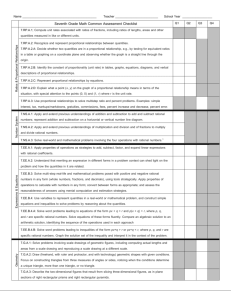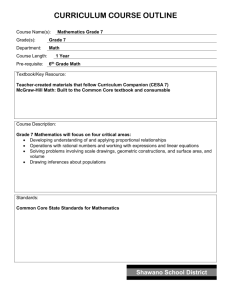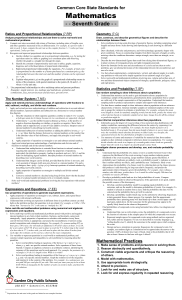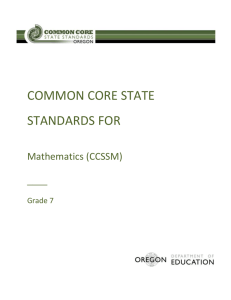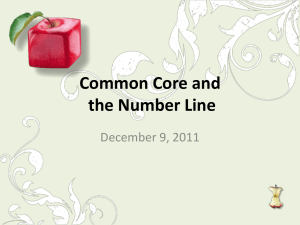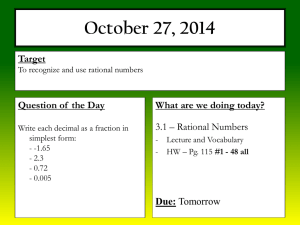Curriculum Map Resource Holbrook
advertisement
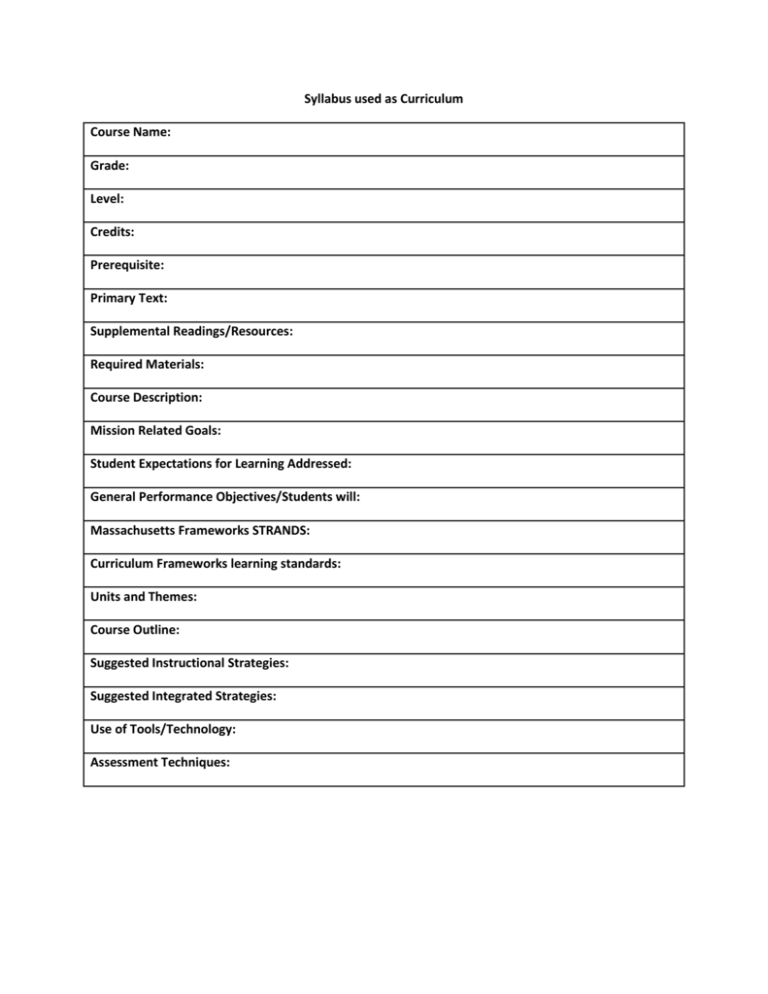
Syllabus used as Curriculum Course Name: Grade: Level: Credits: Prerequisite: Primary Text: Supplemental Readings/Resources: Required Materials: Course Description: Mission Related Goals: Student Expectations for Learning Addressed: General Performance Objectives/Students will: Massachusetts Frameworks STRANDS: Curriculum Frameworks learning standards: Units and Themes: Course Outline: Suggested Instructional Strategies: Suggested Integrated Strategies: Use of Tools/Technology: Assessment Techniques: Syllabus used as Curriculum Course Name: 7th Grade Mathematics Grade: 7th Grade Level: NA Credits: NA Prerequisite: NA Primary Text: Prentice Hall Common Core Course 2 Supplemental Readings/Resources: CMP2 units Required Materials: pencil, pen, notebook or binder and paper, scientific calculator Course Description: – Grade 7 Mathematics continues the trajectory towards a more formalized understanding of mathematics that occurs at the high school level that began in Grade 6. Students extend ratio reasoning to analyze proportional relationships and solve real-world and mathematical problems; extend previous understanding of the number system and operations to perform operations using all rational numbers; apply properties of operations in the context of algebraic expressions and equations; draw, construct, describe, and analyze geometrical figures and the relationships between them; apply understandings of statistical variability and distributions by using random sampling, making inferences, and investigating chance processes and probability models. As in all mathematics courses, the Mathematical Practice Standards apply throughout each course and, together with the content standards, prescribe that students experience mathematics as a coherent, useful, and logical subject that makes use of their ability to make sense of problem situations. Mission Related Goals: (based on NEASC Core Values and Beliefs) Student Expectations for Learning Addressed: (based on NEASC Core Values and Beliefs) General Performance Objectives/Students will: Massachusetts Frameworks Domains and Clusters: Ratios and Proportional Relationships Analyze proportional relationships and use them to solve real-world and mathematical problems. The Number System Apply and extend previous understandings of operations with fractions to add, subtract, multiply, and divide rational numbers. Expressions and Equations Use properties of operations to generate equivalent expressions. Solve real-life and mathematical problems using numerical and algebraic expressions and equations. Geometry Draw, construct and describe geometrical figures and describe the relationships between them. Solve real-life and mathematical problems involving angle measure, area, surface area, and volume. Statistics and Probability Use random sampling to draw inferences about a population. Draw informal comparative inferences about two populations. Investigate chance processes and develop, use, and evaluate probability models. Curriculum Frameworks Learning Standards: The Number System Apply and extend previous understandings of operations with fractions to add, subtract, multiply, and divide rational numbers. 7.NS.1 Apply and extend previous understandings of addition and subtraction to add and subtract rational numbers; represent addition and subtraction on a horizontal or vertical number line diagram. a. Describe situations in which opposite quantities combine to make 0. For example, a hydrogen atom has 0 charge because its two constituents are oppositely charged. b. Understand p + q as the number located a distance |q| from p, in the positive or negative direction depending on whether q is positive or negative. Show that a number and its opposite have a sum of 0 (are additive inverses). Interpret sums of rational numbers by describing real-world contexts. c. Understand subtraction of rational numbers as adding the additive inverse, p – q = p + (–q). Show that the distance between two rational numbers on the number line is the absolute value of their difference, and apply this principle in real-world contexts. d. Apply properties of operations as strategies to add and subtract rational numbers. 7.NS.2 Apply and extend previous understandings of multiplication and division and of fractions to multiply and divide rational numbers. a. Understand that multiplication is extended from fractions to rational numbers by requiring that operations continue to satisfy the properties of operations, particularly the distributive property, leading to products such as (–1)(–1) = 1 and the rules for multiplying signed numbers. Interpret products of rational numbers by describing real-world contexts. b. Understand that integers can be divided, provided that the divisor is not zero, and every quotient of integers (with non-zero divisor) is a rational number. If p and q are integers, then –(p/q) = (–p)/q = p/(–q). Interpret quotients of rational numbers by describing real-world contexts. c. Apply properties of operations as strategies to multiply and divide rational numbers. d. Convert a rational number to a decimal using long division; know that the decimal form of a rational number terminates in 0s or eventually repeats. Ratios and Proportional Relationships Analyze proportional relationships and use them to solve real-world and mathematical problems. 7.RP.1 Compute unit rates associated with ratios of fractions, including ratios of lengths, areas, and other quantities measured in like or different units. For example, if a person walks ½ mile in each ¼ hour, compute the unit rate as the complex fraction ½/¼ miles per hour, equivalently 2 miles per hour. 7.RP.2 Recognize and represent proportional relationships between quantities. a. Decide whether two quantities are in a proportional relationship, e.g., by testing for equivalent ratios in a table, or graphing on a coordinate plane and observing whether the graph is a straight line through the origin. b. Identify the constant of proportionality (unit rate) in tables, graphs, equations, diagrams, and verbal descriptions of proportional relationships. c. Represent proportional relationships by equations. For example, if total cost t is proportional to the number n of items purchased at a constant price p, the relationship between the total cost and the number of items can be expressed as t = pn. d. Explain what a point (x, y) on the graph of a proportional relationship means in terms of the situation, with special attention to the points (0, 0) and (1, r ) where r is the unit rate. 7.RP.3. Use proportional relationships to solve multi-step ratio and percent problems. Examples: simple interest, tax, markups and markdowns, gratuities and commissions, fees, percent increase and decrease, percent error. Units and Themes: Course Outline: Suggested Instructional Strategies: Suggested Integrated Strategies: Use of Tools/Technology: Assessment Techniques:
